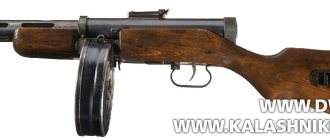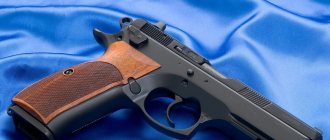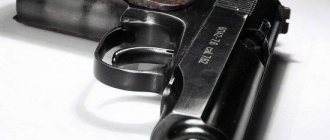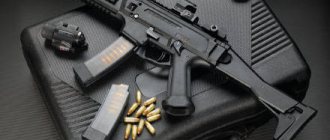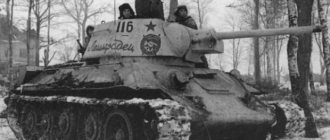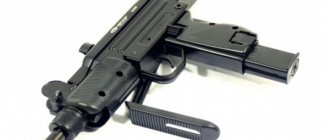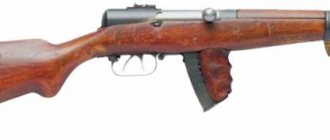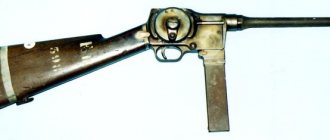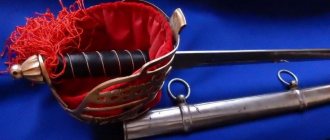Although automatic weapons (directly machine guns and machine guns) have taken a leading position since the Second World War, submachine guns have remained in service. It may seem that in the 40s they did not exist as a class, but the legendary Soviet “PPSh” and the German “Schmeiser” (MR-40, which was actually invented not by Schmeiser, but by Volmer) are nothing more than pistols - machine guns.
Use of submachine guns (SMGs) during WWII
Despite the confidence of ordinary people, submachine guns were not as effective as they seem from war films about the Second World War. Their tactical and technical potential is not intended for firing at long distances, so they were weapons:
- Officers;
- Tankers;
- Artillerymen;
- Scouts and other units, except infantry.
Infantrymen armed with submachine guns simply would not reach the enemy, because... SMGs were not intended for long-range combat.
Looking at modern models of SMGs, it is difficult to believe that they are relatives of legendary military weapon models, but it was in the first two post-war decades that submachine guns acquired the dimensions familiar to us.
History of creation
Submachine guns were originally conceived as army weapons. It was believed that in trench warfare they would be ideal for attacks and storming trenches. However, World War II turned out to be maneuverable, and in it submachine guns, which did not have a long range, only complemented repeating rifles.
Scorpion vz 61
In the post-war period, when intermediate-sized cartridges began to be mastered, the situation of submachine guns worsened even further - they began to disappear from the troops, remaining only where small dimensions were the main requirement.
In the 50s, when the Czechoslovak army was being rearmed, designer Miroslav Rybaž began developing light automatic weapons for arming special forces.
The original plan was to do something reminiscent of the Soviet Stechkin pistol - convert the new CZ52 pistol into a fully automatic one. However, this idea turned out to be unsuccessful, and the design had to be created from scratch.
Prototypes were ready already in 1959, and in 1961 the submachine gun was officially adopted into service as the “model of 1961 (Samopal vzor 1961).” He also received his own name “Scorpio”.
Scorpion submachine gun – the birth of a legend
Although after the advent of machine guns, submachine guns (with their then-dimensions) remained out of use in the army, compact weapons capable of firing pistol bullets were needed by the police and various special groups, who often had to fight in a confined space. For such operations, automatic weapons had to be compact, and high-power ammunition was not needed. Gunsmiths in many countries began to create more compact models based on military SMGs, the characteristics of which had to meet new tasks.
Although Czechoslovakia has always been famous as a country where excellent weapons are produced, compact submachine guns appeared there quite late. This is explained by the fact that initially the designers took the wrong path (although they tried to create the most compact model), trying to make a submachine gun based on a conventional pistol.
Not only did the designers try to create a PP based on a pistol, they also chose an extremely unusual model for this - the CZ52. This pistol was different:
- Non-standard design, which had a large number of parts;
- General unreliability and “capriciousness”;
- Had a very fragile drummer.
Most likely, this pistol was chosen as a “donor” for its power and high shooting accuracy.
Despite several years of fruitless attempts, the idea turned out to be a failure, since the prototype very quickly became unusable due to the high rate of fire, and it itself turned out to be unreasonably expensive and unreliable. This project was considered unsuccessful, and the disgraced gunsmiths put all their efforts into creating a new model, which became the Scorpion submachine gun.
Description and features
Scorpio is a predatory arachnid creature. He has 8 legs. One pair of limbs ends in claws. The segmented tail with a curved spike at the end gives it a recognizable appearance. All 1,750 known species are similar in appearance but vary in size. Length varies from 1.3 cm to 23 cm.
The body consists of two main parts (togmata): the head and abdominal sections. The abdominal part, in turn, consists of a wide anterior and caudal posterior parts. The back part consists of five elements. A segment is attached to the latter, which ends with a needle. The end of the needle has two outlets for the toxin. The scorpion in the photo always shows a curved tail with a needle.
The poison is generated by glands. They are surrounded by muscles, during the contraction of which the fluid produced by the glands flows through the ducts to the end of the needle, and from there into the victim’s body. The head part is the union of the head and chest, the so-called cephalothorax or Cephalothorax. The cephalothorax is covered with a chitinous membrane.
On the head there are eyes and a mouth. At the mouth there are chelicerae - food processes, they function like jaws. Behind them come the pedipalps - claws. This is followed by three pairs of limbs that enable the arachnid to move.
The eyes are located on the upper part of the cephalothorax. Scorpio is an animal that can have from one to six pairs of eyes. The most advantageous position is occupied by the two main eyes. They are called median and are located at the top of the cephalothorax. The rest play the role of additional eyes, located on the left and right sides of the front of the body.
The middle eyes are the most complex. They cannot provide a contrast image, but they are the most sensitive visual organs among arachnids. They are able to sense even minor light fluxes. This allows you to distinguish the contours of the surrounding world in the dark.
Submachine gun "Scorpion Vz.61"
Having created a new model of a submachine gun in a short time, Czech craftsmen once again confirmed that the weapons school in the country is at the highest level. Although this Scorpio model is over 50 years old, it can easily be mistaken for a more modern development.
All design elements of the submachine gun are so well thought out that firing and carrying this weapon does not cause any inconvenience to the owner. The design was developed for use in cold climates, so all switches and fuses of the PP are large enough, which allows you to switch them even with thick winter gloves.
The Scorpion PP is made very ergonomically; when worn, not a single part of the pistol clings to clothing or equipment (even when carried concealed). Although the bolt handles protrude slightly outward (on both sides of the pistol), this does not interfere with wearing at all. After several trainings with this weapon, you get used to this feature, and it does not cause any inconvenience.
The Scorpion PP has a convenient switch for firing modes and setting the weapon to safety, which is located above the weapon handle. You can easily reach it with the thumb of the hand that holds the weapon. This makes it possible to instantly remove the weapon from the safety lock or switch it to automatic fire mode.
The aiming device in this model is the simplest (front and rear sight), however, there are very rare modifications with an optical sight. Although the use of such sights is not justified on light submachine guns, which are often intended for concealed carry and fire at close ranges.
Scorpion feeding system. Scorpion ammunition supply system (5 photos)
The Russian company has developed a universal ammunition supply system designed to improve the combat qualities of existing machine guns. The creation of a new product, designated “Scorpion,” was carried out on its own initiative, without an order from the military department or law enforcement agencies. In order to increase the ammunition capacity of the machine gun, ready for use, it was decided to abandon the standard boxes for tapes, replacing them with a larger container and a special device for feeding the cartridge belt to the receiving window of the machine gun.
In its current form, the Scorpio system consists of several main parts. To store the belt with cartridges, a metal container box of appropriate dimensions is intended. Connected to it is a special flexible hose for supplying cartridges, at the other end of which there is a bracket for mounting on a machine gun. This architecture of the kit allows the production of various variants, both stationary and portable. The Scorpio kit includes several basic elements. A metal container box is used to store and carry the belt with cartridges. In its basic configuration, it measures 40x10x30 cm and holds 475 rounds in one belt.
To carry the box, it is proposed to use a special backpack, adjustable in accordance with the anatomy of the shooter. A special cover with fastenings for a flexible hose is installed on the cartridge box. The sleeve itself is a structure made up of a large number of metal segments that can change position relative to each other within certain sectors. The length of the sleeve is 160 cm, width 10 cm, thickness – 2.5 cm, which allows it to hold up to 75 rounds. If necessary, the sleeve is equipped with a protective cover. The sleeve is equipped with a bracket that allows it to be connected to a weapon. The kit without cartridges weighs about 4.1 kg.
According to the manufacturer, in the basic configuration the Scorpion kit is intended for use with 7.62x54 mm R rifle cartridges and loose metal belts. In preparation for shooting, a single belt for 550 rounds is placed in the box and sleeve. The end of the tape is brought to the receiving window of the weapon. The Scorpion system is designed for use with Kalashnikov machine guns: PK, PKM and Pecheneg using a 7.62x54 mm cartridge. The Scorpion can be used for any task - be it patrolling in the forest, or targeted assault operations in urban areas. And here, it is also very important to mention that you can carry the ammunition system while equipped in different ways.
No piece of equipment will interfere with the use of a box with a flexible sleeve. So, for example, the Scorpion can be worn in conjunction with any means of personal armor protection - a machine gunner can use a bulletproof vest, armored helmet or anti-fragmentation suit, if necessary. The developer of the system has already come up with a proposal to put the Scorpion into service, including its inclusion in the Ratnik system. However, at the moment, the issue is being resolved. However, a number of such products are already used by representatives of various structures.
Here is a simple, cheap, reliable and easy-to-use flexible hose for supplying ammunition “Scorpion” - a system that allows a fighter to carry ammunition in a container behind his back and fire using a flexible belt to supply ammunition.
The initiative development has successfully passed a test cycle at one of the test sites near Moscow and is ready for mass production. According to the designer, during testing and development, all possible delays during firing were eliminated. By increasing the amount of ammunition available for consumption before reloading the weapon, the Scorpion significantly increases the degree of freedom of action in firing. The increase in the degree of freedom of action occurs due to the expansion of the cycle available to the shooter to suppress and defeat the target. The standard firing cycle includes searching for a target, firing, and reloading the weapon. At the same time, reloading the weapon interrupts the cycle and forces it to start again - with searching for the target and firing: this reduces the chances of hitting the target within one cycle. Increasing the amount of ammunition available for consumption before reloading a weapon increases the duration of the firing cycle and the chances of hitting the target.
In theory, “Scorpio” will make it possible to revolutionize the shooting systems used by the armed forces; in practice, the fate of the development depends on the inertia of the thinking of the military-technical leadership and the efforts of the arms lobby. An advanced achievement, superior to its American counterpart and providing an opportunity to break the impasse of “continuous improvement of the Kalashnikov assault rifle and its analogues,” went unnoticed by the domestic military-industrial complex. The simplicity of the design allows the portable container to be reloaded in the field using ammunition loaded into a flexible self-disintegrating tape. 475 cartridge in the main compartment and 75 in the belt.
“Scorpion” does not restrict movement and allows you to fire from any position; in the manufacturer’s version, the container fits into a backpack.
The Scorpion steel belt is not so much a piece of equipment – but rather a prologue and starting point in the evolution of small arms and combat tactics. An opportunity to formulate a path, the end result of which will significantly change the appearance of rifle units of the armed forces - the development of an automatic rifle chambered for 7.62x54 with ammunition from a belt.
The new weapon must have high technological properties: the ability to withstand a high rate of fire and prolonged load on the barrel bore and gas mechanics, high accuracy and accuracy. The overall success in creating a new rifle will be its reliability and weight and size characteristics. The most significant criterion is the low weight of the weapon, which is necessary to reduce the degree of freedom penalties from the steel belt, which with its weight affects the free movement of the weapon in the hands of the shooter. The ideal embodiment of the new system would be a rifle with a tape receiver integrated into the body, the ability to conduct automatic fire without significant recoil and great wear resistance. Successful development will open up the prospect of switching to 7.62x54 as a single ammunition for rifle units. In theory, abandoning intermediate cartridges and returning to the 7.62x54 rifle caliber is a necessity. Firstly, domestic intermediate ammunition does not guarantee the destruction of modern personal protective equipment. Secondly, 7.62x54 is the most common ammunition in the range of small arms. Adding a new assault rifle chambered for a similar cartridge to the range of machine guns and sniper rifles is easier than trying to create the entire range of small arms from scratch and developing several new types of ammunition. Thirdly, 7.62x54 is not a technological innovation for the domestic military-industrial complex, which significantly simplifies the process of creating a new assault rifle. Under these conditions, the transition to 7.62x54 as a single ammunition will reduce the range of cartridges and rifle systems produced by the domestic military-industrial complex. Which, combined with the refusal to produce a large number of different cartridge clips, will lead to significant savings. The theory is easily criticized - there are now many special ammunition and new developments that are used to a limited extent by the armed forces. However, from the point of view of military construction, it is cheaper, easier and faster to produce a single cartridge for ammunition for machine guns and assault rifles. Small arms account for the lion's share of consumption of the total amount of all ammunition consumed by rifle units. On the scale of an army or a high-intensity conflict, this is a significant saving of production forces, time, and alleviation of the logistics load when supplying troops.
The use of a new concept of ammunition will significantly increase the consumption of ammunition in battle and will cause an increase in the logistics load when supplying troops - therefore, a general reduction in the range of consumable items is an important factor in mitigating such a load.
A logical step in the evolution of the new concept will be the development of a new machine gun chambered for 7.62x54 cartridge with similar technological properties. The need to develop a new machine gun is due to increased requirements for wear resistance, since the use of a new ammunition system increases the duration of the load during continuous firing. An attempt to create a hand-held 30 mm grenade launcher based on similar principles is also possible.
The concept of a new ammunition supply system, in combination with the creation of a new rifle complex, will allow: to increase the firepower of rifle formations several times, to reduce the range of products produced at military-industrial complex enterprises - by abandoning the production of cartridge clips, to reduce the logistics load when supplying troops on the front line, to switch to single cartridge 7.62x54. To do this, it is necessary to adopt the “Scorpion” system or its analogue into service - as an integral part of the “Ratnik” equipment for every serviceman leading a shooting battle. is not capable of developing a new assault rifle; moreover, the prospect of reducing the range of products produced by military-industrial complex enterprises, due to the unification of ammunition and the abandonment of obsolete cartridge clips and boxes for machine guns and machine guns, creates internal competition, which will be impossible to overcome without a fundamental solution. In turn, the decision to switch to a new principle of ammunition supply, change the appearance of rifle units and develop a new rifle complex will, at a minimum, be postponed. At least because of the “Warrior” program. The reputation of “program success” for responsible managers may be more valuable than the prospects of a new concept. Despite the fact that advanced developers of small arms systems were unable to fulfill the task of the “Ratnik” program to create a fundamentally new small arms system. In the conditions of the domestic military-industrial complex, “Scorpion” and the new concept of shaping the appearance of rifle units of the armed forces may be postponed at least until 2022.
In theory, the evolution of the concept of belt ammunition and the mass use of Scorpions in a rifle unit makes it possible to solve a higher priority task - increasing the number of missiles and special weapons in rifle units, without losing the ability to conduct a full-fledged rifle battle. At the same time, there is no need to create new types of hand-held anti-tank, anti-aircraft, missile and other special weapons. It is enough to increase the firepower of an ordinary rifleman several times and there will immediately be a place in the rifle squad for a second grenade launcher.
In practice, the evolution of the concept is impossible without adopting an analogue of the Scorpion into service and setting the task for its mass use among the troops. In order for the Institute of Military Staff Thought to work, it needs a task, it is impossible, without a series of maneuvers and serious research, to determine to what extent the use of belt feed systems and an increase in the firepower of the rifle squad relieves the squad personnel and allows them to free up staff for the use of special weapons. It takes practice. Since the basic principles of the concept - the development of a new assault rifle, significantly increase the importance of one shooter, you can count on a positive result in matters of increasing the degree of freedom in the construction of units.
Owners of patent RU 2399004:
The system for feeding cartridges into the barrel of a weapon is designed for automatic and semi-automatic firearms. The system contains a magazine with cartridges installed in the weapon socket, a magazine retention latch and a cartridge feeder. The system is equipped with a bolt stop and a mechanical connection of the magazine holding latch with cartridges or a bolt stop, while the magazine holding latch is configured to open when the magazine is empty or when there is the last cartridge in it, as well as a lock with an additional latch mechanically connected to the protrusion made on weapon and located in the path of movement of the bolt of the weapon or associated elements to prevent premature detachment of the magazine from the weapon. The invention simplifies charging and reduces the reloading time of weapons by self-disconnecting the magazine when the ammunition is used up. 2 n. and 8 salary f-ly, 6 ill.
The invention relates to automatic and semi-automatic firearms and is applicable to weapons of any small caliber systems.
Ammunition supply systems are known, consisting of a magazine with a spring-loaded feeder and a magazine socket on the weapon /see. for example, “Manual on small arms business” M.: Military Publishing House 1970 p.4-19/. The disadvantage of this system is that after the cartridges are used up, the magazine must be removed. In addition, the carob-shaped magazine is inconvenient to insert and remove, because movement in an arc is less orthopedicly convenient for the loader’s hand - a simple direct movement is performed more confidently and quickly, so reloading an open-arm magazine takes 1 second longer than a straight one. And the experience of combat operations in Afghanistan revealed the urgent need to reduce the reloading time of weapons, especially machine guns. In addition, when firing from a machine gun, if the trigger is released immediately after the last cartridge is used up or when firing single rounds, the end of the cartridges goes unnoticed, which can lead to the death of a soldier.
The technical result is the simplification of charging and self-detachment of the magazine when the ammunition is used up, which is an alarm about the end of cartridges.
To do this, the magazine retention latch is mechanically connected to the feeder in the upper or upper (if there is one cartridge in the magazine) position, or to an element mechanically connected to the feeder or to the cartridges, and if the magazine has an indirect, for example horn-shaped, then its working the end has straight guides. The mechanical connection can be located both in the weapon and in the magazine, and in the latter case, with some design solutions, the stop for the latch located in the magazine can serve as a counter latch located in the weapon. In systems where the opening of the latch is not designed to empty the magazine, but to the last cartridge, there is a magazine release lock in the form of an additional latch, mechanically connected to a protrusion located in the path of movement of the bolt or associated elements.
The design designed for the last cartridge differs from the first in that in the first design the magazine is separated after the last shot, when the bolt moves back and releases the feeder. In this case, the weapon remains ineffective for some time.
And in a design designed for the last cartridge, the magazine is separated before the last shot in the cartridge loading phase. In this case, the weapon, at least when firing single shots, remains charged all the time.
For more efficient separation of the magazine from the weapon, there is an ejector spring attached to the magazine or weapon. And so that during practice shooting the magazine does not fall on a hard surface or in the mud, there are loops on the magazine and weapon to which carabiners of the safety cord are connected.
The mechanical connection can be carried out either directly or through a rod, a double-armed or single-armed spring-loaded or spring lever, etc.
Figure 1 shows a block diagram of the ammunition supply system. Figure 2 shows four specific examples of the location of straight guides on a horn magazine. Figures 3-6 show specific design solutions.
Structurally, the system consists of element 1, which senses the end of ammunition or the moment when there is one cartridge or a unitary shot left in the magazine; this can be a feeder, an element associated with it, for example, a bolt stop in a PM pistol, or the cartridges themselves. A mechanical connection 2 interacts with this element, and with it a latch 3 for holding the magazine body 4.
In designs designed for the last cartridge, to prevent premature detachment of the magazine, there is a latch 5 of the lock, connected to a protrusion 6 in the path of the bolt or the element 7 connected to it. To speed up the separation of the magazine, there is an ejector spring 8.
This system works as follows: when the cartridges are used up, element 1 opens latch 3 through a mechanical link 2 and the empty magazine 4, under the influence of its own weight and spring 8, is separated from the weapon. In designs designed for the last cartridge, after the latch 3 is released, the magazine is held by the lock latch 5 until the last cartridge is removed from it by the bolt 7, which / or the element associated with it / when rolling presses on the protrusion 6, opening the latch 5 blocker. The store is separated.
Figure 2 shows the main options for the location of the guides 9 on the body 4 of the horn magazine. Intermediate ones are also possible.
Depending on the type of magazine /straight, open-end, disk, drum/ and the type of mechanical transmission (direct, rod, pusher, one- or two-armed lever, shaft, etc./, and the location of the mechanical connection and latch, various examples are possible specific execution.
The systems in Figs. 3-5 consist of a magazine body 4 with a feeder 10, spring-loaded by a spring 11. To hold the magazine there is a latch 3, and for manual release there is a flag 12. Moreover, in Figs. 3, 5 the latches are formed by bending an elastic plate on which and fasten.
In Fig.3 there is also a rod 13, attached, for example by contact welding, to the feeder 10 and the flag 12.
Figure 4 shows staggered cartridges 14, between the tips of which there is a protrusion 15 of a double-armed lever 16, spring-loaded by a spring 17 and mounted on an axis 18 inside the guide 19.
In Fig. 5, the latch 3 is located on an elastic plate 20 attached to or part of the rear wall of the magazine, and the stop for the latch 3 is an additional latch 21 in the form of an elastic plate bent at an angle, one end attached to the body of the weapon. On the magazine body 4 there is a protrusion 22 for the latch 5 of the lock 23, which is mounted on the axis 24 and has a protrusion 6 located in the path of rolling the handle 25 of the bolt frame.
Figure 6 shows a magazine 4 in a weapon socket 26. In the wall of the socket there is a groove 27, in which there is a cup 28 with a tooth 29. An ejector spring 8 that works in tension is attached to the cup and the bottom of the groove.
The systems in Fig.3, 4 operate as follows: as the cartridges are consumed, the feeder 10, under the action of the spring 11, moves to the open end of the magazine 4 and after the last cartridge is used up through a mechanical connection in the form of a rod 13 /Fig.3/ or a protrusion 15 on the lever 16 /Fig.4/ opens the latch 3 and the magazine falls out of the weapon under its own weight.
The system in Fig. 5 operates similarly, except that the latch 3, under the action of the elastic plate 20, enters the groove of the feeder 10 at a time when there is still one cartridge left in the magazine. This happens after the rollback, and so that the magazine does not prematurely separate along with the last cartridge, it is held by the protrusion 22 by the latch 5 of the lock 23.
During the roll-up, the cartridge is sent into the barrel and at the same time the bolt or, in relation to the AKM assault rifle, the bolt frame with its handle 25 presses on the protrusion 6 of the lock and the empty magazine is separated. Moreover, if the shooting was carried out with single shots or the trigger was released at that moment, the weapon remains combat-ready during reloading: at any moment it is ready to fire one shot. To reload, all that remains is to insert a new magazine and, without distorting the bolt, you can continue shooting. It should be added that in this case it is desirable to use a slide stop in the machine gun, similar to the PM pistol.
For faster and more reliable separation of the magazine, the above systems may have a push-out spring 8 /Fig. 6/, which, when attaching the magazine, stretches, and after detaching the magazine, it compresses and with the tooth 29 of the cup 28 pushes out the empty magazine 4.
The use of the invention will significantly increase the combat effectiveness of motorized rifle and airborne troops, especially in short-term oncoming, close-in, urban battles.
1. A system for feeding cartridges into the barrel of a weapon, containing a magazine with cartridges installed in the weapon socket, a magazine holding latch and a cartridge feeder, characterized in that it is equipped with a bolt stop and a mechanical connection of the magazine holding latch with cartridges or a bolt stop, wherein the holding latch The magazine is configured to open when the magazine is empty or when there is the last cartridge in it.
2. The system according to claim 1, characterized in that it is equipped with straight guides for mounting a curved magazine in the weapon socket.
3. The system according to claim 1, characterized in that said mechanical link is located in the magazine.
4. The system according to claim 1, characterized in that said mechanical link is located in the weapon.
5. The system according to claim 1, characterized in that the magazine retention latch is made with a protrusion located in the weapon.
6. The system according to claim 1, characterized in that it is equipped with an ejector spring located between the magazine and the weapon and attached to the magazine or to the weapon.
7. The system according to claim 1, characterized in that said mechanical connection is made in the form of a rod between the cartridge feeder and the magazine retention latch.
8. The system according to claim 1, characterized in that said mechanical connection is made in the form of a spring-loaded or springy double-armed or single-armed lever.
9. The system according to claim 1, characterized in that said mechanical connection is effected by direct contact between the magazine retention latch and the cartridges or bolt stop.
10. A system for feeding cartridges into the barrel of a weapon, containing a magazine with cartridges installed in the weapon socket, a magazine retention latch and a cartridge feeder, characterized in that it is equipped with a lock with an additional latch mechanically connected to a protrusion made on the weapon and located in the path of movement the bolt of the weapon or elements associated with it to prevent premature detachment of the magazine from the weapon, and the magazine retention latch is configured to open when the magazine is empty or when there is the last cartridge in it.
Colonel E. Maksimov
In foreign countries, in order to increase the efficiency of reconnaissance on the battlefield, the protection of objects for various purposes, as well as timely notification of the movement of people, ground equipment and low-flying aircraft (helicopters) in tactical (operational-tactical) depth, development and supply activities are being consistently carried out to the troops of new and modernization of systems and complexes of reconnaissance and signaling devices (RSD) in service.
The US Army is armed with the Scorpion Unattended Target Recognition Systems (SCORPION Unattended Target Recognition Systems), manufactured by the American company. It is designed for covert remote detection and tracking of the movement of people, ground equipment, as well as for classifying objects in tactical (operational-tactical) depth.
Reconnaissance and signaling devices of the Scorpion system can be used to solve such problems as: - surveillance of areas in which concentration or movement of enemy troops is possible or expected; — conducting reconnaissance of the most likely routes for their advance and deployment; — determination of directions and intensity of troop movements; — protection of the locations of their troops, barriers, approaches to bridges, etc.; — ensuring the protection of important military facilities together with other technical means to prevent the penetration of reconnaissance and sabotage groups and terrorists into their territory; — protection of state border areas, dividing lines of opposing forces and demilitarized zones.
The Scorpion system is made using a flexible architecture, and its electronic components are characterized by high reliability and low cost in the supply and sales market. In addition, the RSP complex is easily configured and deployed with a full range of remote monitoring and control of each component in the system, down to the individual sensor.
Depending on the tasks being solved, the system may include RSPs with four types of sensors (seismic, magnetometric or combined seismic/magnetometric, acoustic, passive infrared), optoelectronic observation devices, radio repeaters, data processing and control stations (SODU, wearable and portable). If necessary, it may additionally include hydroacoustic sensors, as well as chemical and radiation reconnaissance sensors. All RSPs are installed manually, and the time required for this does not exceed several minutes. The devices are made in a special protective metal case and are designed for operation in adverse climatic conditions.
Combined (seismic/magnetometric) RSP and optoelectronic observation devices are additionally equipped with Navstar CRNS to provide topographic reference.
Each reconnaissance and alarm device includes: one sensor, an electronic processing unit with a VHF transmitter and a battery.
The electronic processing unit is pre-installed with a universal software for pre-processing data from various types of sensors.
To increase the efficiency of sensors and reduce the likelihood of false alarms, the RSP uses sensitivity threshold adjustment. To determine the direction to an object, the system uses a goniometric method. The maximum communication range with the radio repeater is up to 2 km.
When the power supply of the RSP is turned on, testing is carried out automatically, during which its performance is monitored and the type of connected sensors is determined. If the device is ready for operation, information about this is transmitted via a radio repeater to the data processing and control station. The activation of the sensor in the electronic processing unit of the RSP generates a coded signal, which is then transmitted in the same way to the command post.
Optoelectronic surveillance devices of the “Phoenix” type are designed for remote automatic detection of moving targets in a given field of view at any time of the day and in adverse weather conditions. The reconnaissance range using the device is up to 800 m. The system includes a digital black-and-white daytime video camera (the operating wavelength range reaches the near-IR region of the spectrum) and an IR camera based on an uncooled focal matrix.
The optoelectronic surveillance device is mounted on a tripod and masked with a camouflage cover. Pointing it at the target is carried out with the receipt of “alarm” signals from other RSPs, as well as remotely - according to the operator’s commands. When a moving target is detected, the device automatically tracks it, performs primary processing, compresses video images in the standard JPEG 2000 format and transmits it via cable line to a radio repeater.
The radio repeater ensures the reception of data from the RSP and its transmission to the data processing station located at the control points. One radio repeater can serve up to 800 radio stations.
The system uses two types of radio repeaters: short-range radio communication (provides it in the VHF range at a line-of-sight range) and over-the-horizon communication.
The over-the-horizon radio repeater, in addition to the standard VHF transmitter, is equipped with a transceiver for the Iridium commercial satellite communication system and a connector for connecting an external optoelectronic surveillance device.
Short-range radio repeaters are used when protecting military facilities, and those equipped with a satellite transmitter are used when conducting reconnaissance.
The portable SODU is made on the basis of a portable small-sized personal computer, the operation of which is controlled by the Windows 2000 SP4 or XP Professional SP2 operating system. It performs a number of functions: it provides programming of specified operating modes of the RSP, remote control and monitoring of their functioning, automatic registration and systematization of incoming data, as well as remote guidance of optoelectronic devices at specified objects.
Portable SODU is located at command posts and in combat control centers. It is PC-based and, in addition to the wearable version, provides final processing of intelligence information and the formation of a database. Special station software allows you to track the location of objects in the controlled area and display data from the radar station in real time against the background of an electronic map of the area.
The Scorpion system operates autonomously, and its sensors can operate continuously for up to three months. Sufficient flexibility of this tool is provided through the use of universal transceivers that are programmed to work with sensors using a wearable data processing and control station. The presence of universal hardware and software allows the use of reconnaissance and alarm devices of a different class in the system, for example, Rembass-2, Falcon Watch and Classic.
In order to increase the effectiveness of combat support for troops at the tactical level, the Scorpion-2 RSP system was developed and put into experimental combat operation. Unlike the previous one, it uses combined-type devices, which have smaller weight and size characteristics and power consumption, as well as doubled continuous operation time (up to six months).
This device includes three sensors - seismic, magnetometric and passive infrared. They provide detection and recognition of objects at a distance of over 100 m.
In total, the US Army has more than 1,000 sets of the Scorpion system. Their high efficiency and reliability have been confirmed during combat operations in Afghanistan and Iraq. Distinctive features of this system are: - modular, open and scalable architecture for customizing the RSP during combat operations (operations); — adapted, safe, two-way communication through short-range VHF radio lines or over-the-horizon communication (Iridium satellite communication system); — functional compatibility with various types of sensors (seismic, magnetometric or combined seismic/magnetometric, acoustic, passive infrared); — low energy consumption of system elements, increased time of their continuous operation, etc.
In the US Armed Forces, work to improve RSP systems and reconnaissance sensor systems in the period until 2022 involves constant modernization of existing models, providing for the replacement of individual devices, as well as the introduction of fundamentally new information technologies that expand their functionality.
According to American experts in the field of electronic reconnaissance equipment, the use of the Scorpion RSP system during combat operations can significantly reduce the losses of personnel and equipment, as well as reduce the number of forces and means required both for reconnaissance and for the protection of objects.
| Table 1 Main performance characteristics of sensors | ||
| Characteristic | Combined (seismic/magnetometric) | Passive IR |
| Detection range, m: | ||
| person | 3-15 | 50-100 |
| vehicle | 25-50 | 100-200 |
| Maximum speed of movement of detected objects, km/h: | ||
| person | 5-7 | |
| vehicle | 45-50 | |
| Operating temperature range, in ° C | from -25 to +60 | from -25 to +60 |
| Table 2 Main performance characteristics of optoelectronic surveillance devices | ||
| Characteristic | IR camera | Camcorder |
| Operating wavelength range, microns | 8-12 | 0,4-0,7 |
| Detection/recognition range, m: | ||
| person | 300/200 | ./300 |
| vehicle | 800/400 | ./800 |
| Size of the matrix of sensitive elements, pixels | 640×480 | 720×576 |
| Field of view angle, degrees. | 9,3 | 5,5 |
| Focal length, mm | 75 (F/1(0) | 50 (F/1.8) |
| Table 3 Main performance characteristics of radio repeaters | ||
Variety of different modifications of the Scorpion submachine gun
Many modifications of stocks have been developed for the Scorpion software, ranging from stationary ones made of wood to various folding options. In addition, it was possible to attach an additional handle to hold the submachine gun with both hands.
Since changes in the caliber of cartridges around the world brought new models of small arms or modernized models of old ones onto the world stage, the designers of the Scorpion software also had to modernize their design. Unlike the same Kalashnikov assault rifle, the design of the Czech submachine gun turned out to be quite advanced, so modernization of the weapon consisted only of changing the caliber. Throughout all the years of production, the caliber of the Scorpion PP changed from 7.65x17 to 9x19. In one case, this was due to the adoption of a new caliber, in others, due to the need for this weapon to enter the world market.
The modifications were minimal due to the fact that the design of the submachine gun successfully resolved the issue of reducing the rate of fire. The Scorpion software is equipped with a special shutter catcher in the form of a simple hook. You can often hear the opinion that the operation of the catcher significantly reduces shooting accuracy, but the minimal weight of the bolt and moving parts in the pistol handle does not create deviations of the weapon when firing (especially since the maximum firing distance for a weapon of this type is 150-200 meters).
Interesting Facts
Modern biology, in addition to describing the appearance of scorpions and their life activity, has a number of interesting facts concerning these animals. One of these is the immunity of arthropods to radiation (up to 1000 roentgens) . Thus, after a nuclear explosion on Earth, only scorpions can survive.
Scorpios eat only live food. They never share their prey with their relatives. Finding themselves together in a small enclosed space, individuals will kill each other for the opportunity to eat, but will not give up food. These creatures can survive without food for 1.5 to 2 years.
Scorpions are the first arthropods to emerge from water onto land. The length of aquatic fossil arthropods reached one meter. Due to the fact that scorpions are able to move perfectly along walls, they can easily climb into windows located on the 3rd or 4th floors.
Submachine gun "Scorpion" model Vz.61
This model of PP is closest to modern models of submachine guns. It was in it that the designers managed to embody the ideas of compactness and minimal weight. This weapon can be fired with either one or two hands, which shows how compact the model is. Although from the point of view of modern submachine guns, the Vz.61 model lacks shot power, further upgrades, which changed the caliber and type of cartridges used, managed to increase combat effectiveness.
Very often, this submachine gun was used by various terrorists, which brought it public fame. Although this reputation is rather dubious, it suggests that the model is quite problem-free.
Currently, any Russian citizen who has a license for a traumatic weapon can join the legendary model of the Czech submachine gun. Several years ago, Scorpion PP was brought to gun stores chambered for a traumatic cartridge. This model does not have the ability to fire automatically and will only be of interest to collectors or fans of this brand. It is not recommended to use the Scorpion PP for self-defense (as well as the hunting version of the PPSh).
The most famous species
There are many different species of these arthropods in the world. Among them are quite unusual representatives that are difficult to find in the wild. Of the 1,750 species, only 50 individuals produce toxic poison that can kill a person or harm his health.
Imperial (Pandinus imperator)
This variety of scorpions is not only very beautiful, but also the largest among similar animals. The length of one body often reaches 15 centimeters, and taking into account the claws and tail - 25 cm. Imperial species are distinguished by their black color, in which a green tint can be seen. Individuals have wide claws with impressive thickness.
Their life expectancy in the natural environment reaches 14 years. The emperor scorpion lives in the tropical forests of western Africa. In stones, burrows they dug or under leaves on the ground, arthropods hide from sunlight and daytime heat. The diet of young organisms consists of small insects; adult specimens attack small rodents and amphibians.
Woody (Centruroides exilicauda)
Representatives of this species have a monochrome coloration, expressed in various tones of yellow; there are also varieties with black stripes or the same dots. The body of adult creatures has a length of up to 7.5 cm. Scorpions have long claws and a tail with a thickness of up to 5 mm.
This species lives in the deserts of Mexico and the United States, as well as in the forests of northern Africa. Unlike their relatives, these arthropods do not dig holes; pieces of tree bark, rock crevices and residential buildings serve as shelter. For humans, such a neighborhood poses a certain danger, since the bite of this animal is fatal to children, as well as elderly and sick people. The scorpion's diet consists of various insects, lizards and mice. They often hunt their relatives.
Desert hairy
The body of Hadrurus arizonensis is dark brown and the tail is light yellow. This type of coloring, combined with the long hairs growing on the scorpion’s tail and paws, distinguishes it from its relatives. Adults, including tail and claws, reach a length of 17 cm.
The desert hairy species is found in southern California and Arizona. During the daytime, these arthropods hide under stones or in burrows dug by them. They feed on all kinds of beetles, cockroaches, moths, crickets and other insects.
Black Fattail
The thick-tailed androctonus is common in the deserts of the UAE and reaches a length of 12 cm. Individuals have different colors: from black to red-brown or olive. During the daytime, this species finds shelter under stones, in cracks of buildings and fences near places where people live. Androctonus feed on all kinds of insects and small vertebrates. The main difference between these scorpions is their massive tail.
Yellow (Androctonus australis)
The species of yellow fat-tailed scorpions lives in the Middle East, the Arabian Peninsula, Pakistan, East India, and also in Afghanistan. These individuals are distinguished by their pale yellow body color. Their sting can be either black or dark brown. The length of adults usually reaches 12 cm. Habitat is deserts or foothills
From daylight and heat, yellow androctonus take refuge in rock gorges and burrows. In order to feed itself, this animal hunts small insects. The characteristics of a scorpion should include the presence of deadly poison. The substance is so strong that 2 hours after the bite it is fatal. Currently, no antidote has yet been found against it.
Scorpion submachine gun, performance characteristics
The technical characteristics of the Scorpion submachine gun are as follows:
- The length of the PP is 517 mm with the butt unfolded and 270 if the butt is folded;
- The barrel length is 115 mm;
- Weight without magazine is 1.28 kilograms;
- Magazines come in two types, 10 and 20 rounds;
- Cartridges come in several calibers, depending on the modification of the weapon (from 7.65 to 9.17);
- The rate of fire is 850 rounds per minute;
- The effectiveness of the shot is guaranteed at a distance of about 25 meters.
As can be seen from the characteristics, the Scorpion submachine gun is not much inferior to modern PP models.
